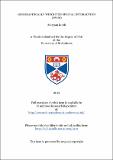Geographically weighted spatial interaction (GWSI)
Abstract
One of the key concerns in spatial analysis and modelling is to study and analyse similarities or dissimilarities between places over geographical space. However, ”global“ spatial models may fail to identify spatial variations of relationships (spatial heterogeneity) by assuming spatial stationarity of relationships. In many real-life situations spatial variation in relationships possibly exists and the assumption of global stationarity might be highly unrealistic leading to ignorance of a large amount of spatial information. In contrast, local spatial models emphasise differences or dissimilarity over space and focus on identifying spatial variations in relationships. These models allow the parameters of models to vary locally and can provide more useful information on the processes generating the data in different parts of the study area.
In this study, a framework for localising spatial interaction models, based on geographically weighted (GW) techniques, has been developed. This framework can help in detecting, visualising and analysing spatial heterogeneity in spatial interaction systems. In order to apply the GW concept to spatial interaction models, we investigate several approaches differing mainly in the way calibration points (flows) are defined and spatial separation (distance) between flows is calculated. As a result, a series of localised geographically weighted spatial interaction (GWSI) models are developed.
Using custom-built algorithms and computer code, we apply the GWSI models to a journey-to-work dataset in Switzerland for validation and comparison with the related global models. The results of the model calibrations are visualised using a series of conventional and flow maps along with some matrix visualisations. The comparison of the results indicates that in most cases local GWSI models exhibit an improvement over the global models both in providing more useful local information and also in model performance and goodness-of-fit.
Type
Thesis, PhD Doctor of Philosophy
Items in the St Andrews Research Repository are protected by copyright, with all rights reserved, unless otherwise indicated.
Related items
Showing items related by title, author, creator and subject.
-
Spatial patterns and species coexistence : using spatial statistics to identify underlying ecological processes in plant communities
Brown, Calum (University of St Andrews, 2012-11) - ThesisThe use of spatial statistics to investigate ecological processes in plant communities is becoming increasingly widespread. In diverse communities such as tropical rainforests, analysis of spatial structure may help to ... -
Accommodating false positives within acoustic spatial capture–recapture, with variable source levels, noisy bearings and an inhomogeneous spatial density
Petersma, Felix T.; Thomas, Len; Thode, Aaron M.; Harris, Danielle; Marques, Tiago A.; Cheoo, Gisela V.; Kim, Katherine H. (2023-08-07) - Journal articlePassive acoustic monitoring is a promising method for surveying wildlife populations that are easier to detect acoustically than visually. When animal vocalisations can be uniquely identified on an array of sensors, the ... -
Spatial capture-recapture analysis of artificial cover board survey data reveals small scale spatial variation in slow-worm Anguis fragilis density
Schmidt, Benedikt R.; Meier, Anita; Sutherland, Chris; Royle, J. Andy (2017-09-13) - Journal articleVague and/or ad hoc definitions of the area sampled in monitoring efforts are common, and estimates of ecological state variables (e.g. distribution and abundance) can be sensitive to such specifications. The uncertainty ...

